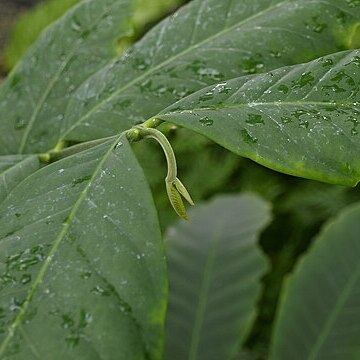Tree to about 25 m. tall, frequently shrubby at higher elevations in Central America. Leaves approximately 18-40 cm. long; leaflets 2-3(-5) pairs, broadly elliptical, occasionally broadly obovate, the base obtuse to acute, the apex obtuse to obtusely long-acuminate, the veins frequently darker than the blade beneath, glabrous above and beneath, rarely minutely puberulent along the veins beneath. Inflorescences shorter than the leaves (rarely elongate in specimens from the upper Amazon drainage), often cauliflorous, 3-18 cm. long (in specimens seen from Panama), paniculate, rarely nearly racemose, glabrous, infrequently minutely puberulent. Flowers white or cream, sometimes tinged with rose, 4 (rarely 5)-merous; calyx cupulate, frequently split at one side, the lobes rounded to very short minutely puberulent without; staminal tube usually entire, glabrous; anthers 8 (-10); ovary glabrous, borne on a thick gynophore. Capsule dull red, glabrous, usually 4-valved, the largest capsule seen about 4 cm. in diam., usually definitely 4-lobed, shorter than broad, sometimes lenticellate, 4-celled, with 1 or 2 seeds per cell; seeds 4/5 covered by a red aril, the remaining 1/5 covered by a white caruncle on the axial side.
More
A tree. It grows 30-50 m high. It has small buttresses. The leaves are compound. The flower groups are about 12 cm long. The flowers are yellowish-white. The fruit stalks are thickened and 0.7 cm long. The fruit is an oval capsule. It is 4 cm long by 3.8 cm wide. It is reddish-brown. There are 4-8 seeds. These have 2 flat and 1 curved side. It is 2.5 cm long by 1.3 cm wide. The fleshy layer on the seeds is edible. The seeds hang on long stalks.
A tree of dense primary forests, found in most forest formations, though only near rivers in the drier regions. When growing at higher elevations, the plant is often shrub-like.
More
It is a tropical plant. It grows in rainforest especially along rivers. In Argentina it grows from sea level to 1,000 m above sea level.


